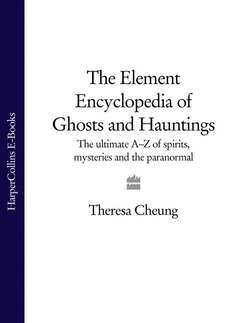Читать книгу The Element Encyclopedia of Ghosts and Hauntings: The Complete A–Z for the Entire Magical World - Theresa Cheung, Theresa Cheung - Страница 70
BLAVATSKY, MADAME [1831–1891]
ОглавлениеHelena Petrovna Blavatsky, daughter of Russian aristocrats, was a key figure in the nineteenth-century revival of occult and esoteric knowledge. A highly intelligent and energetic woman, she helped to spread Eastern philosophies and mystical ideas to the West and tried to give the study of the occult a scientific and public face.
Blavatsky became aware of her psychic abilities at an early age. She travelled through the Middle East and Asia learning psychic and spiritual techniques from various teachers, and she said that it was in Tibet that she met the secret masters or adepts who sent her to carry their message to the world.
In 1873 Helena immigrated to New York, where she impressed everyone with her psychic feats of astral projection, telepathy, clairvoyance, clairsentience and clairaudience. Her powers were never tested scientifically, but her interests were always more in the laws and principles of the psychic world than psychic power itself. In 1874 Helena met and began a lifelong friendship with Colonel Henry Steel Olcott, a lawyer and journalist who covered spiritual phenomena, and a year later they founded a society ‘to collect and diffuse a knowledge of the laws which govern the Universe’. They called this society the Theosophical Society, from theosophy, a Greek term meaning ‘divine wisdom’ or ‘wisdom of the gods’.
Travelling to India, Blavatsky and Olcott established themselves at Adyar, near Madras, and a property they bought there eventually became the world headquarters of the society. They established the nucleus of the movement in Britain and founded no fewer than three Theosophical Societies in Paris.
Throughout her life Blavatsky’s powers were dismissed as fraud and trickery, but this did not stop the Theosophical Society from finding a home among intellectuals and progressive thinkers of her day. The society was born at a time when spiritualism was popular and Darwin’s theory of evolution was undermining the Church’s teachings, so the Society’s new thinking flourished. Many people appreciated the alternative it provided both to church dogma and to a materialistic view of the world.
Blavatsky’s two most important books are Isis Unveiled and her magnum opus, The Secret Doctrine, published in 1888. She drew her teachings from many religious traditions: Hinduism, Tibetan Buddhism, Platonic thought, Jewish Kabbalah and the occult and scientific knowledge of her time. Although they influenced many people, her books are extremely difficult to read. Nevertheless, her teachings were absorbed by many people and then simplified into a worldview that was taken up by many later New Age groups. This worldview includes a belief in seven planes of existence; the gradual evolution and perfecting of spiritual principles; the existence of nature spirits (‘devas’); and belief in secret spiritual masters or adepts from the Himalayas, or from the spiritual planes, who guide the evolution of humanity. All of these beliefs are derived from Blavatsky’s Theosophy.
